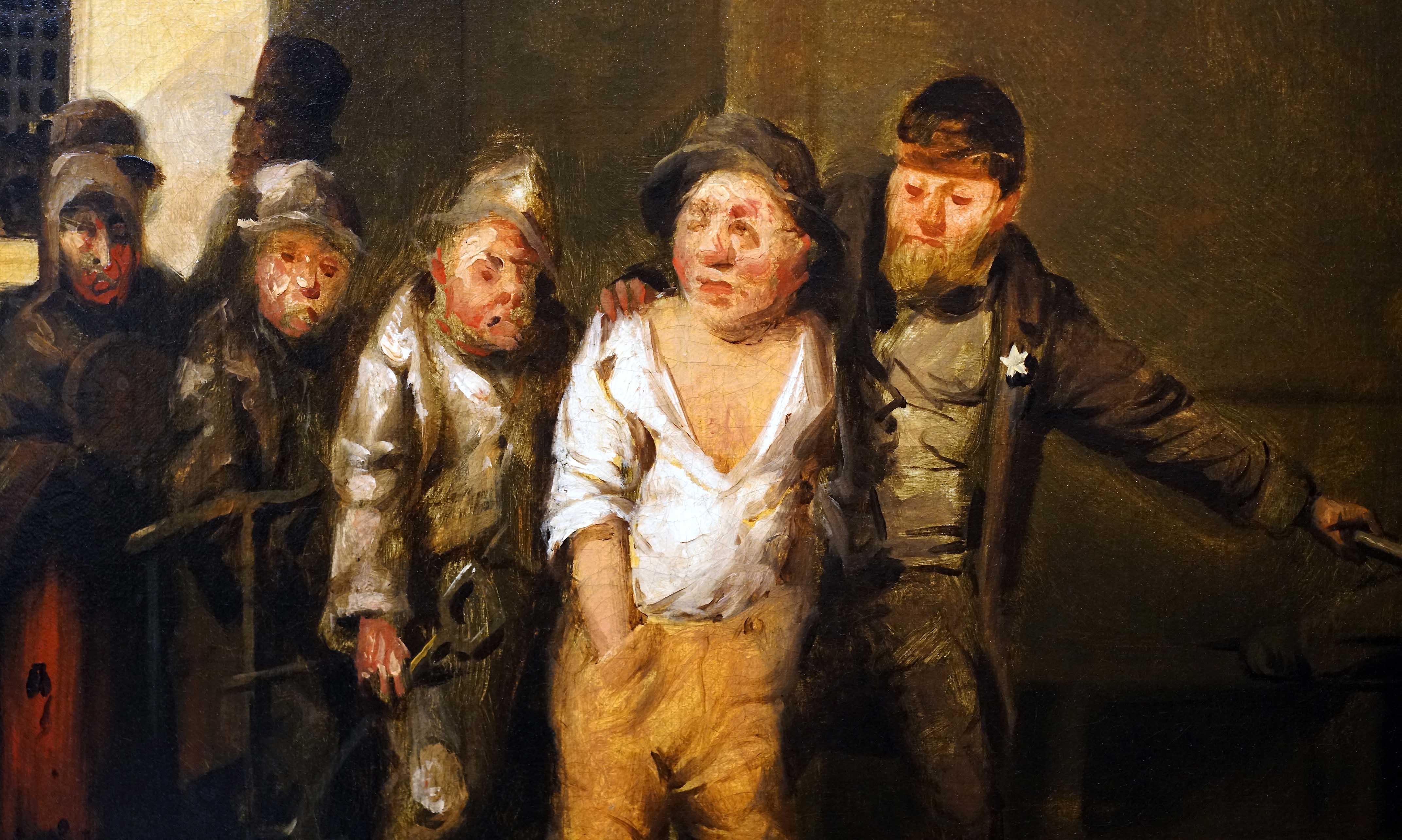
David Gilmour Blythe, Justice (detail), c. 1860, oil on canvas, 51.1 x 61.3 cm (Fine Art Museums of San Francisco)
The rise of nativism in the United States
Essay by Dr. Kimberly Kutz Elliott
From the birth of the United States through the mid-nineteenth century, a small but steady stream of European immigrants flowed into the young nation. Most newcomers to the country in these early years—apart from the kidnapped Africans forced to immigrate before the international slave trade was banned in 1808—were comfortable both financially and culturally. They spoke English, hailed from Protestant nations, and were quickly welcomed into the American body politic. The Naturalization Act of 1790 permitted any “free white person” to become a U.S. citizen after two years of residency, and in some states male European immigrants had the right to vote as soon as they arrived. [1]
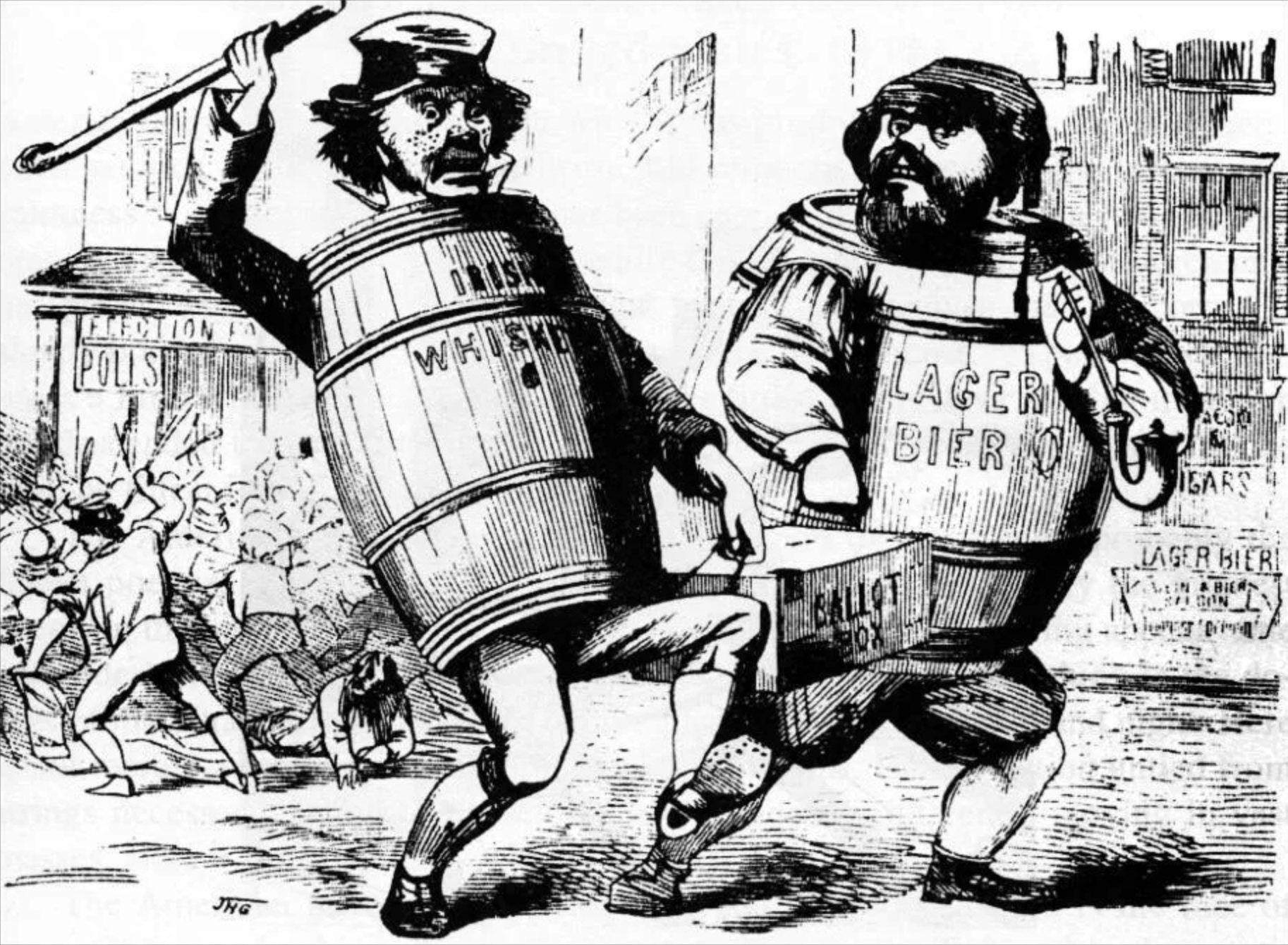
1850s political cartoon, likely penned by political cartoonist John H. Goater, showing caricatures representing Irish and German voters “stealing an election.” The man at center left is carrying a club and wearing a barrel labeled “Irish Whiskey,” with a wild expression on his face. Next to him stands a man wearing a barrel labeled Lager Bier (intended to parody German beer) and carrying a pipe. Between them, they carry away a ballot box while a mob scene ensues at the building labeled “Election Day Polls” behind them. The cartoonist expresses a fear that immigrant voters have too much political power (New York Public Library Research Collections).
By the 1850s, however, that small stream of immigrants had grown into a mighty river: famine and revolution in Europe drove unprecedented numbers of immigrants to American shores. More than five times as many people immigrated to the United States in 1854 than in 1844, and most of the new immigrants were poor, Catholic laborers from Ireland or Germany. By 1860, more than 13% of U.S. inhabitants had been born elsewhere. Because the new immigrants were disproportionately young adults, their impact on the ballot box was even more pronounced. [2] Some native-born Americans began to fear that the existing laws governing naturalization and voting rights were too generous toward newcomers. A political cartoon from the 1850s expressed the sentiment that these new immigrants—considered too drunken and violent to wield political power wisely—were poised to “steal” American elections, depicting caricatures of Irish and German men carrying away the ballot box.
In northern cities, which had the largest immigrant populations, nativism—a set of beliefs favoring the interests of established inhabitants against those of immigrants—emerged in the 1830s but grew to a fever pitch by the late 1840s. White, native-born Americans felt threatened by immigrants on nearly every front. Economically, immigrants desperate for work might undercut wages for native-born laborers and artisans; politically, immigrants were a tempting bloc of voters whose fast-growing influence might eclipse that of native-born men. But the most insidious aspect of the new immigrants, in the eyes of nativists, was their Catholic faith.
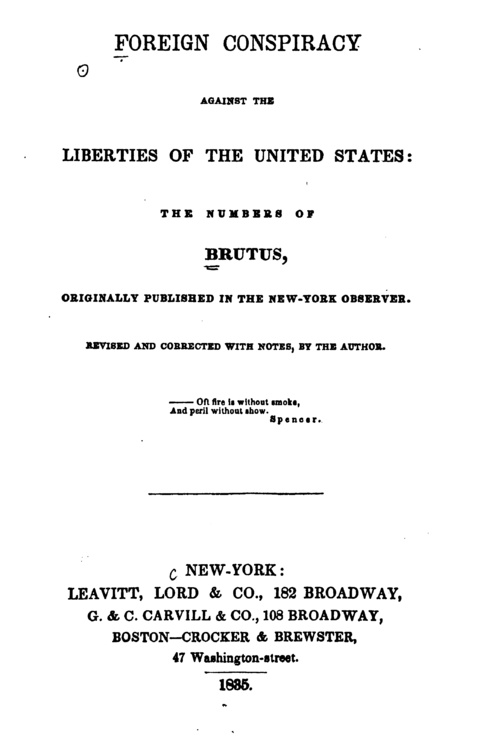
Frontispiece of Samuel F. B. Morse’s nativist tract “Foreign Conspiracy against the Liberties of the United States” (Leavitt, Lord & Co., 1835). Morse, who is most famous for inventing the telegraph and Morse code, was also a well-known painter. He was strongly anti-Catholic and anti-immigrant, and ran for mayor of New York City in 1836 as a member of the Nativist Party, the forerunner of the Know-Nothing Party.
Although the United States had no established church, it maintained a strong Protestant tradition. Despite a few pockets of Catholic toleration (notably Maryland), most states extended religious tolerance only to a few Protestant denominations. Many Protestant Americans saw the United States as carrying on the mission of its Puritan founders, and they tended to view Catholicism with suspicion. Because the Pope claimed authority from God, and answered to no earthly power, Americans saw him as the archenemy of democracy.
Nativists feared that Catholic immigrants would serve the interests of the Pope rather than those of the United States. Samuel F.B. Morse, most famous today as the inventor of the telegraph and Morse Code, was also a strident nativist who wrote pamphlets warning of the dangers of immigrants. In his 1835 polemic “Foreign conspiracy against the liberties of the United States,” Morse alleged that immigrants “are not fitted to act with judgment in the political affairs of their new country, like native citizens educated from their infancy in the principles and habits of our institutions. Most of them are too ignorant to act at all for themselves, and expect to be guided wholly by others. . . . [T]hey are but obedient instruments in the hands of their more knowing leaders to accomplish the designs of their foreign masters.” [3] Such conspiracy theories, which held that Catholics were scheming to place the United States under the thrall of the Vatican, abounded in nineteenth-century American print culture.
In northern cities, nativists began to form secret societies, like the “Order of United Americans” and the “Order of the Star-Spangled Banner,” whose members vowed to vote only for native-born candidates for elected office and to oppose Catholic “aggressions” such as efforts to secure public funding for parochial schools. By 1854, hundreds of lodges for these societies dotted the country, drawing their membership primarily from young clerks, artisans, and laborers. When outsiders asked them about these societies, they were instructed to answer “I know nothing.” [4]
The Know-Nothing Party
Although their secretive nature precludes an accurate count of their numbers, historians estimate that about a million people belonged to these nativist societies in the 1850s. They emerged as a political force in the form of the Know-Nothing Party (officially, the American Party, but the secret society catchphrase stuck). From relative obscurity, the Know-Nothing Party became a powerful movement practically overnight.
In 1854, Know-Nothings swept the Massachusetts state legislature (all but three of its new members belonged to the party) and also captured the mayor’s office in cities like Philadelphia, Chicago, and San Francisco. In Baltimore, nativist gangs like the Blood Tubs and Plug Uglies made sure that voters cast their ballots for the Know-Nothings—or else. The party quickly came to dominate state legislatures in New England and won seats in Maryland, Tennessee, and Kentucky.
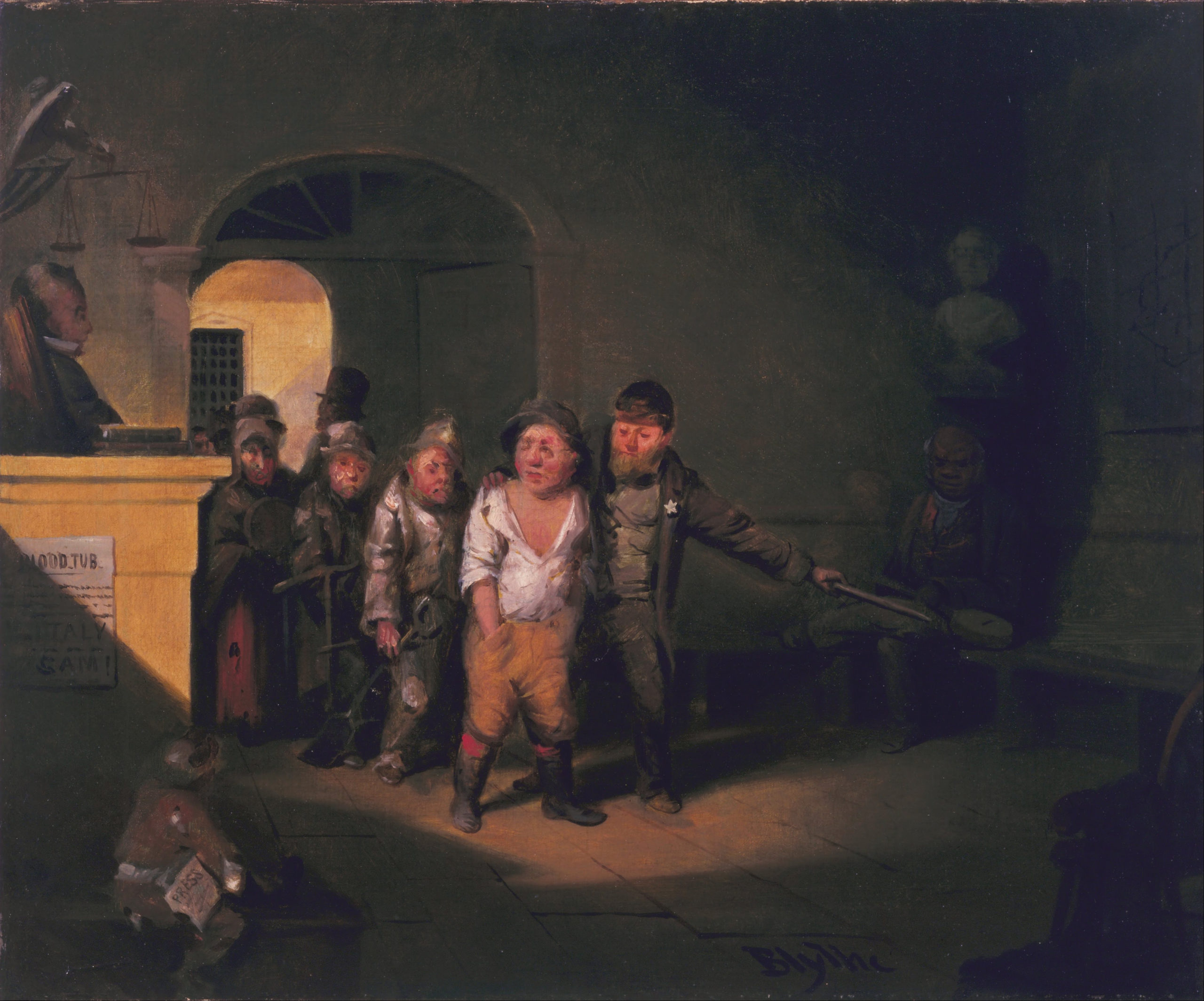
David Gilmour Blythe, Justice, c. 1860, oil on canvas, 51.1 x 61.3 cm (Fine Art Museums of San Francisco). A poster referencing the Blood Tubs, a Baltimore gang supporting the Know-Nothings, is fixed to the bench below the judge at bottom left. In the center, a police constable leads a disheveled man into the courtroom, gesturing with a nightstick. The central figure has a bleary expression and rosy cheeks, suggesting he may be drunk, and the figures behind him seem to be poor working people, likely recent immigrants. At the top left sits a stern judge, and below him a member of the press whose face is hidden from view. Sitting on a bench in the dim right side of the composition is a Black man holding a banjo, beneath a classical bust on a plinth. The dark colors and slanting light of the painting give it an uneasy feeling, as if all involved know that justice is not going to be done in this courtroom. Blythe was known to harbor nativist sentiments, and his unsympathetic rendering of this painting’s subjects suggests he viewed immigrants as criminal.
The major issue of the Know-Nothing platform was limiting the political power of foreign-born men. Because Know-Nothings operated at the state and local level, their precise policy initiatives differed from region to region, but they did share some common elements. Know-Nothings championed voter suppression laws, such as increasing the naturalization waiting period to 21 years, imposing a further waiting period after naturalization before new citizens could vote, and restricting officeholding to native-born citizens. They opposed public funding for religious schools. Some Know-Nothings also favored temperance measures, which would outlaw the sale of alcohol (including, not coincidentally, the sacramental wine important to Catholic worship).
How did the Know-Nothing Party gain such influence in such a short time? In large part, they owed their success to the collapse of the Second Party System, a twenty-six year era during which the two major U.S. political parties were the Democrats and the Whigs. But when the Whig party—hopelessly split over slavery—disintegrated in the early 1850s, a period of political realignment ensued. Two new parties emerged to vie for the votes of former Whigs: the anti-slavery Republican Party, and the anti-immigrant Know-Nothing Party. In the mid-1850s, which of these would ultimately become the major-party opponent to the Democrats was anybody’s guess.
Each new party had something to tempt former Whigs. The Know-Nothings’ nativist stance promised them a way to limit the political power of their old foes, the Democrats, who attracted the votes of new immigrants. Therefore, nativist policies that disenfranchised immigrants would help to keep the Democratic Party in check. In addition, the Know-Nothings adopted some of the Protestant moral reforms, such as temperance, that Whigs had long seen as beneficial to the advancement of society. On the slavery issue, the national Know-Nothings were neutral, which offered a haven in the south for Whigs—and moderate Democrats—turned off by the southern Democrats’ increasingly strident pro-slavery rhetoric.
The Republicans, by contrast, promised a firm commitment to anti-slavery policies, having come together in opposition to the Kansas-Nebraska Act. The Republicans also incorporated Whig economic ideas, favoring the expansion of banking, railroads, and access to western land for white farmers.
The only question was whether nativism and anti-slavery were compatible ideas; that is, could you be against immigrant rights and in favor of containing slavery at the same time? On this, opinion among both Know-Nothings and Republicans was divided. Some northern Know-Nothings saw slavery and Catholicism as twin evils, two powerful institutions bent on oppressing liberty. For them, there was no contradiction between opposing the institution of slavery and opposing the political power of Catholic immigrants. Likewise, some Republicans courted nativists, hoping to take advantage of their votes to further anti-slavery aims once elected. But other Republicans were dismayed by the surge in nativist sentiment, which they considered a distraction from the all-important issue of slavery. Furthermore, they viewed attempts to degrade immigrants as fundamentally at odds with efforts to improve the status of Black people.
In spite of these inconsistencies, the Know-Nothings were quite successful for a new party. At the height of their influence between 1854 and 1856, the Know-Nothings controlled 52 seats in the House of Representatives, including the Speakership, 6 seats in the Senate, and fielded a presidential candidate (Millard Fillmore) who won 21% of the popular vote.
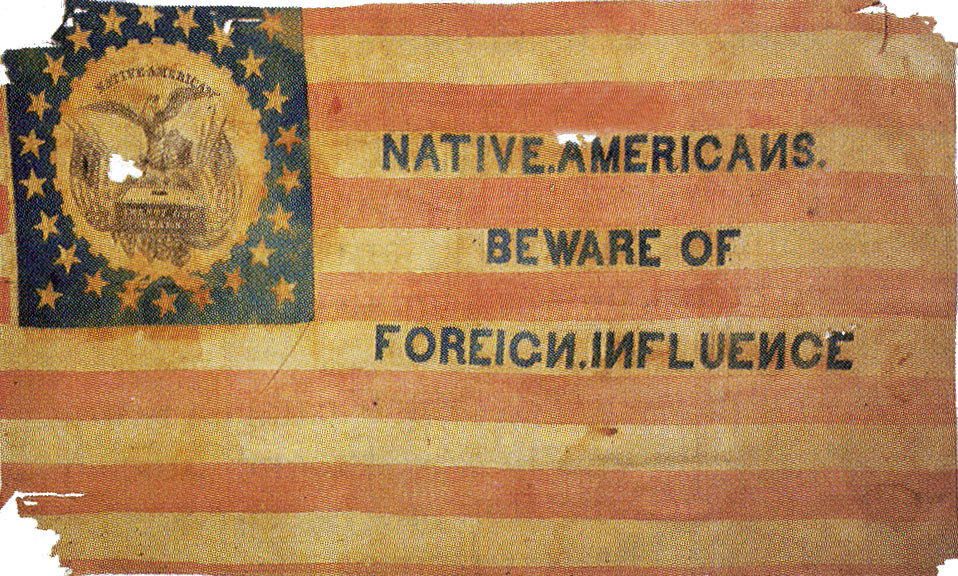
Know-Nothing Party flag, c. 1860. In this context, “Native Americans” refers to native-born citizens of the United States (white non-immigrants), not Indigenous peoples of North America. An earlier incarnation of the Know-Nothing Party was called the Native American Party. The members of nativist secret societies sometimes wore faux “Indian” dress and referred to their leaders as chiefs or sachems. Some nativists did support the rights of Indigenous peoples, arguing that they had a greater claim to American citizenship than immigrants. [5] (image in the public domain)
By 1860, the Know-Nothing Party was no longer a major contender for national office.
Nativism as a lasting political force
The end of the Know-Nothings did not spell the end of nativism or anti-Catholicism as a rallying cry in American politics. After the Civil War, Republicans in the north continued to attack the Irish and the Catholic Church, which were—as they saw it—inextricably linked with the corrupt Democratic party.
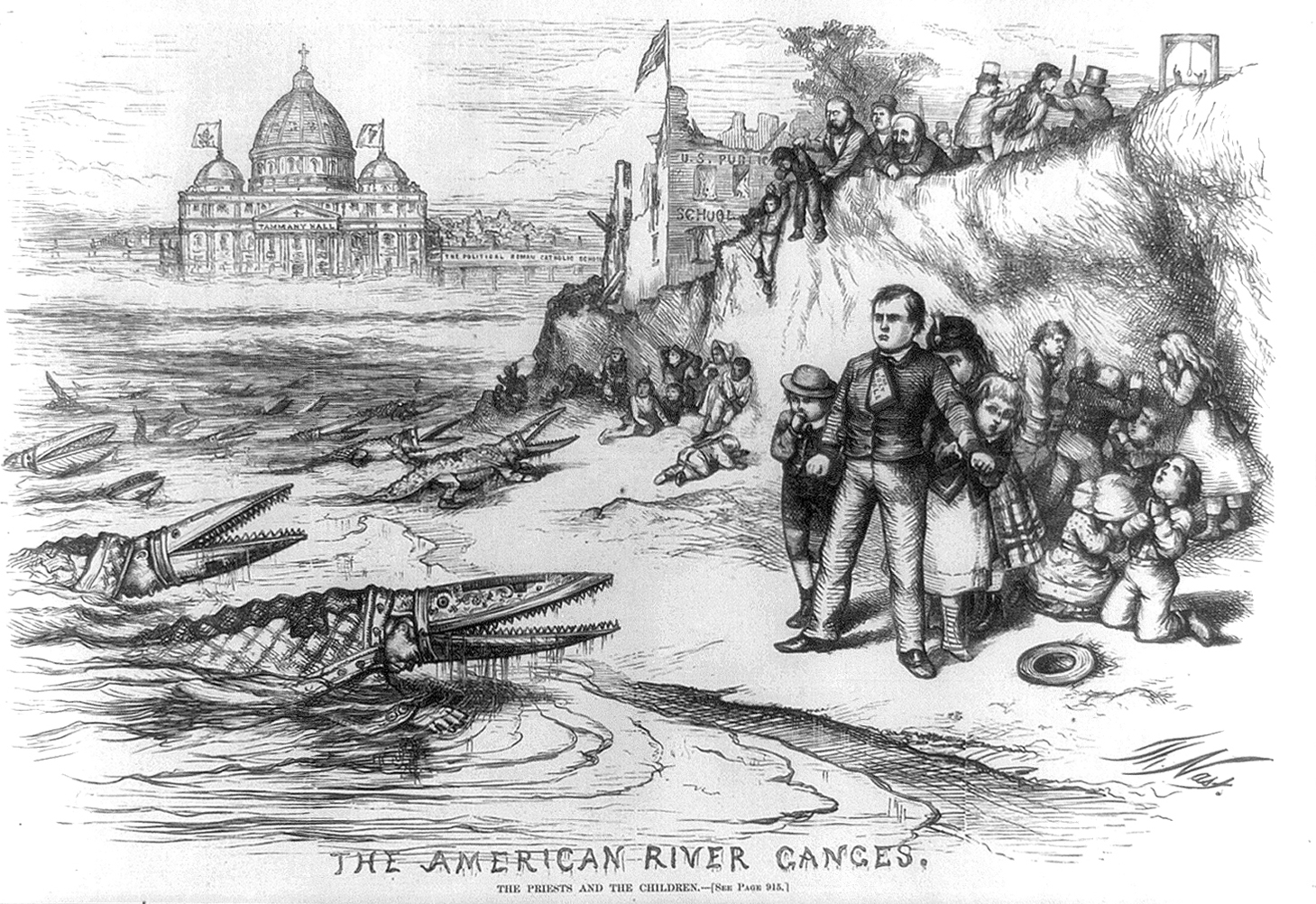
Thomas Nast, “The American River Ganges, The Priests and the Children,” Harper’s Weekly, 1871. In this political cartoon, the children on American shores are beset by “crocodiles,” or bishops whose miters resemble crocodiles, protected by a lone Protestant man with a bible tucked into his shirt. In the background, Tammany Hall (the Democratic political machine in New York City) stands triumphant; its leader, Boss Tweed, stands at the top of the bluff (immediately above the man protecting the children) while his associates drop children into danger. A U.S. public school is crumbling, with the American flag turned upside down in distress. At the top right corner, Columbia—a female allegorical figure representing the United States—is being led to the gallows. (Library of Congress)
Political cartoonist Thomas Nast expressed his support for the rights of formerly-enslaved Black people at the same time as he skewered Catholics. His 1871 political cartoon “The American River Ganges” depicted Catholic bishops as crocodiles who were intent on gobbling up American children. The leaders of Tammany Hall—New York City’s Democratic political machine, rendered as a twin of St. Peter’s Basilica in Rome in the cartoon—were throwing children down to them. Nast alternated cartoons like these with others, like 1874’s “The Union As It Was” that sought the viewer’s sympathy for the persecution of newly-free African Americans in the south.
In the late nineteenth century and early twentieth century, nativism reared its head once again as immigration to the United States reached new heights. Italians and Eastern Europeans fleeing poverty and religious persecution became the “new” immigrants as Irish and Germans became “white.” Congress enacted laws banning Chinese and Japanese immigrants altogether during this period, and eventually passed sweeping measures limiting the stream of immigrants to a trickle. Fear of the “other” has remained a potent force in American society ever since.
Notes:
- On voting for non-citizens see Alexander Keyssar, “The Right to Vote: The Contested History of Democracy in the United States,” (Basic Books, 2009), pp. 27–28. Note that although the international slave trade was outlawed in 1808, some smugglers did continue to import human captives from outside the United States, and the internal slave trade continued to force people of African descent to migrate and labor against their will.
- See Historical Statistics of the United States, 1789-1945, Chapter B—Population Characteristics and Migration (Supplement to the Statistical Abstract of the United States, U.S. Census Bureau, 1949). Because immigrants were more likely to be adults, they constituted a greater percentage of the pool of eligible voters than of the population as a whole.
- Samuel F.B. Morse, Foreign Conspiracy Against the Liberties of the United States, (Leavitt, Lord & Co., 1835), p. 58.
- See James M. McPherson, Battle Cry of Freedom: The Civil War Era (Ballantine Books, 1988), p. 135.
- See Dale T. Knobel, “Know-Nothings and Indians: Strange Bedfellows?” Western Historical Quarterly, vol. 15, no. 2 (April, 1984), 175-198.
Additional resources:
David Gilmore Blythe at the Google Art Project
Know-Nothing research guide at the Library of Congress
Tyler Anbinder, Nativism & Slavery: The Northern Know Nothings and the Politics of the 1850s (Oxford University Press, 1992).
Villanova University Library exhibit on the Know-Nothings
Digital Public Library of America’s exhibit, Political Outsiders in U.S. Presidential Elections

